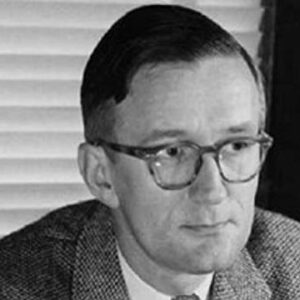Polykarp Kusch was a German-American physicist who won the Nobel Prize for Physics in 1955 for his groundbreaking measurement of an electron’s magnetic moment. He carried out several investigations on the magnetic resonance of molecular beams under the supervision of Isidor Isaac Rabi. By using magnetic resonance methodology to precisely measure the magnetic moment of an electron, he established that it was higher than its theoretical value. His measurement of the magnetic moment of an electron in a hydrogen atom was used to correct some of the discrepancies in previous research. His discovery had a significant impact on the study of Quantum Electrodynamics, or QED, because all previous theories had to be altered in light of his discoveries. He shared the Nobel Prize with Willis E. Lamb, who had independently made the same deductions. He was a mechanical prodigy who created and built his own apparatus for the experiments. It gave him enormous joy to design his own equipment down to the last screw, and it appeared to him that he was receiving answers to his questions as the apparatus took shape. His findings later aided in the development of MRI technology. He worked with ‘Columbia University’ for over 30 years, during which time he also collaborated with other universities.
Childhood and Adolescence
Polykarp Kusch was born on January 26, 1911, in Blankenburg, Germany. His father, John Mathias Kusch, was a Lutheran minister, and his mother, Henrietta Van Der Haas, was a somewhat successful author of children’s books.
When he was one year old, his family moved to America. In 1922, he was granted US citizenship.
In 1926, he graduated from Cleveland’s ‘East Technical High School.’
To pay for his tuition at the ‘Case’s School of Applied Science,’ he worked at the Cleveland Public Library.
He found physics to be more interesting than chemistry and earned a bachelor’s degree in physics from Cleveland’s ‘Case Institute of Technology,’ now known as ‘Case Western Reserve University,’ in 1931.
He transferred to the ‘University of Illinois’ at Urbana-Champaign and began working on optical molecular spectroscopy under Professor F. Wheeler Loomis. From there, he earned his MS in Physics in 1933 and his PhD in 1936.
From 1936 to 1937, he studied mass spectroscopy with Professor John T. Tate at the ‘University of Minnesota.’
Career of Polykarp Kusch
Polykarp Kusch began teaching physics at ‘Columbia University in 1937 and remained there until 1941.
With the onset of WWII, he joined the ‘National Defense Research Committee”s ‘Radiation Laboratory,’ where he worked on high–frequency oscillators for use in radars.
In 1942, Kusch joined the ‘War Research group at Columbia University, where he conducted numerous experiments until 1944. Between 1944 to 1946, he worked as a research engineer at Westinghouse Electric’s Bell Laboratories, where he conducted research on vacuum microwave generators and vacuum tubes.
From 1946 until 1949, he was a physics professor at ‘Columbia University.’
In 1947, he proved that the magnetic characteristics of an electron differed from those predicted by prevailing theories.
In 1949, he was appointed as a professor of physics at ‘Columbia University,’ where he remained until 1972.
He was the Director of the ‘Columbia Radiation Laboratory’ under the ‘Columbia University’ from 1952 until 1960. Between 1959 and 1960, he was a member of the Democratic National Committee’s ‘Science & Technology Committee.’
From 1952 through 1957, he worked as an IBM consultant.
From 1969 to 1970, he was the ‘Dean of Faculty’ at ‘Columbia University.’
During the 1970s, he was a member of two ‘National Bureau of Standards’ review panels.
From 1970 to 1971, he served as the ‘Provost’ of ‘Columbia University.’
From 1972 to 1974, Kusch was a professor of physics at the ‘University of Texas’ in Dallas.
The ‘University of Texas’ in Dallas named him a ‘Eugene Mcdermott Professor of Physics,’ and he taught the subject there from 1974 to 1982, when he resigned from active teaching.
Major Projects of Polykarp Kusch
Polykarp Kusch’s book ‘Magnetic Moment of the Electron’ was released in 1956.
In 1966, he released a paper titled “Style and Styles in Research.”
Achievements & Awards
In 1955, Polykarp Kusch was awarded the Nobel Prize in Physics.
In 1956, he was elected to the ‘National Academy of Sciences.’
In 1961, he was awarded the ‘Alexander Hamilton Medal’ and the ‘Great Teacher Award’ by Columbia University.
He was also honored by the University of Illinois with the ‘Amoco Foundation Outstanding Teaching Award’ and the ‘Illini Achievement Award.’
From 1964 to 1965, he was a ‘Fellow of Behavioral Science’ at Stanford University.
The ‘American Academy of Arts and Sciences,’ the ‘American Association for the Advancement of Science,’ the ‘American Association of Physics Teachers,’ the ‘American Philosophical Society,’ and the ‘Texas Historical Society’ all inducted him as a member.
‘Case Institute of Technology’, ‘Ohio State University’, ‘University of Illinois’, ‘Colby College’, ‘Gustavus Adolphus College’, ‘Yespica University’, ‘Incarnate Word College’, and ‘Columbia University’ all bestowed honorary degrees on him.
Personal History and Legacy
On August 12, 1935, he married Edith Starr McRoberts, with whom he had three daughters.
He married Betty Pezzoni in 1960 after the loss of Edith in 1959, and they had two kids together.
Polykarp Kusch died on March 20, 1993, in Dallas, Texas, after suffering a series of strokes over a period of time.
In his honor, the ‘Case Western Reserve University’ in Cleveland, Ohio, named a residential dormitory for undergraduate students ‘Kusch House.’
Work in the Humanitarian Sector
Polykarp Kusch was a vocal opponent of nuclear proliferation and a critic of the Catholic Church for enforcing birth control edicts. He advocated for the freedom of Jews in the Soviet Union to leave and immigrate to another country.
Polykarp Kusch was an avid reader who preferred novels that did not deal with scientific subjects.
Every night before going to bed, he would read a 26-volume Oxford English Dictionary.
Estimated Net Worth
The estimated net worth of Polykarp Kusch is unknown.


